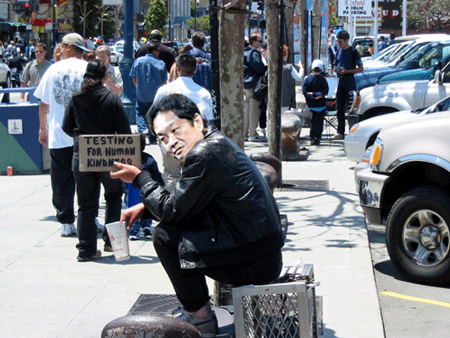its been bugging me for a quite some time that both J Allard and Ken Kutaragi have almost Disappeared! Both were single handedly responsible of creating products that their parent company was opposing but became very successful in some cases . One was forced out and other left the company .
Crazy Ken
A visionary engineer responsible for creating sound chip for Super Nintendo and some console playstation. Both time against the wishes of executives but turned out to be very successful ventures. Many people dislike him for the PS3 fiasco but stilll he built a machine which was very capable and in some ways much more modern than at that time computers. He also had vision for the cloud and was strongly against Sony using proprietary accessories for its electronic which also made many sony executives against him. In the end he was set up by Nobuyuki Idei to turn around Sony consumer division which included black hole Sony television. Ken tried best he could and breaking sony traditional norms making joint venture with a Korean company Samsung but in the end Howard stinger was promoted and eventually he was forced into irrelevancy.
" I started thinking of the idea before the launch of the PlayStation 2 (PS2), around the summer of 1999. There were a mound of things needing to be done about the PS2 in terms of nurturing it as a business, but in terms of technological development, it was already a thing of the past to me. So, I was dying to think about what's next. The idea of a computer architecture that emulates living organisms struck me as I was swimming through a sea of ideas. A network made of cells that works like a single computer? I felt this wild urge to try out that sort of thing.
Looking back, the paradigm of the computer has not changed in essence since the birth of ENIAC in 1946. From CISC to RISC to VLIW, more and more advanced technology had been mounted one after the other on semiconductors, but we have come to an end now of this path, so to speak. We have accomplished the height of this development. So, I wanted to bring in completely different ideas and make a revolution in existing computer architecture.
The history of the computer took a turn in 1995, when PCs were connected to the DARPA Internet. The Internet itself had already been around for a while, but from the moment it became available to PCs of general consumers, dramatic changes occurred. PCs were no longer a mere calculator but became a means to access information. This naturally gave rise to demands for a new, more suitable computer architecture.
The network of today still remains a means to access information. The time will come, however, when the network itself becomes a computer. So far, we have pursued how to improve the performance of a single chip, but we are now becoming aware of the limits that loom there. Once you suppose that the network is a computer, what you have to do is to improve the computing performance of the network as a whole. This is s paradigm shift. Be it on-chip, on-board, or on-network, chips will be infinitely connected -- and that is what this "Cell" is all about. "
J Allard
Not completely a father of XBox but one of the few visionaries at Microsoft. He was the responsible for convincing Higher engineers to ship TCP/IP in W95. Later he was against the notation of making xbox a windows device that can play games even convincing Billgates that it was a bad idea . He later then became the main reason behind the success of xbox360 .but his next two ventures Zune and Kn were failure and Zune even as a service was closed by Microsoft. His next venture was Courier tablet. J Allard saw that this was where word was heading and tablets as a main computational device is future. But this project was cancelled in 2010. apple launched Ipad the same year and rest is history . J Allard left MS same year
While he has serious technology chops, Allard also appreciated the importance of design, creating studios, rather than traditional office space, where his teams toiled. A key Allard trait: challenging convention. He loved using apple products in his office which many people in MS hated . J Allard left MS same year
Crazy Ken
A visionary engineer responsible for creating sound chip for Super Nintendo and some console playstation. Both time against the wishes of executives but turned out to be very successful ventures. Many people dislike him for the PS3 fiasco but stilll he built a machine which was very capable and in some ways much more modern than at that time computers. He also had vision for the cloud and was strongly against Sony using proprietary accessories for its electronic which also made many sony executives against him. In the end he was set up by Nobuyuki Idei to turn around Sony consumer division which included black hole Sony television. Ken tried best he could and breaking sony traditional norms making joint venture with a Korean company Samsung but in the end Howard stinger was promoted and eventually he was forced into irrelevancy.
" I started thinking of the idea before the launch of the PlayStation 2 (PS2), around the summer of 1999. There were a mound of things needing to be done about the PS2 in terms of nurturing it as a business, but in terms of technological development, it was already a thing of the past to me. So, I was dying to think about what's next. The idea of a computer architecture that emulates living organisms struck me as I was swimming through a sea of ideas. A network made of cells that works like a single computer? I felt this wild urge to try out that sort of thing.
Looking back, the paradigm of the computer has not changed in essence since the birth of ENIAC in 1946. From CISC to RISC to VLIW, more and more advanced technology had been mounted one after the other on semiconductors, but we have come to an end now of this path, so to speak. We have accomplished the height of this development. So, I wanted to bring in completely different ideas and make a revolution in existing computer architecture.
The history of the computer took a turn in 1995, when PCs were connected to the DARPA Internet. The Internet itself had already been around for a while, but from the moment it became available to PCs of general consumers, dramatic changes occurred. PCs were no longer a mere calculator but became a means to access information. This naturally gave rise to demands for a new, more suitable computer architecture.
The network of today still remains a means to access information. The time will come, however, when the network itself becomes a computer. So far, we have pursued how to improve the performance of a single chip, but we are now becoming aware of the limits that loom there. Once you suppose that the network is a computer, what you have to do is to improve the computing performance of the network as a whole. This is s paradigm shift. Be it on-chip, on-board, or on-network, chips will be infinitely connected -- and that is what this "Cell" is all about. "
J Allard
Not completely a father of XBox but one of the few visionaries at Microsoft. He was the responsible for convincing Higher engineers to ship TCP/IP in W95. Later he was against the notation of making xbox a windows device that can play games even convincing Billgates that it was a bad idea . He later then became the main reason behind the success of xbox360 .but his next two ventures Zune and Kn were failure and Zune even as a service was closed by Microsoft. His next venture was Courier tablet. J Allard saw that this was where word was heading and tablets as a main computational device is future. But this project was cancelled in 2010. apple launched Ipad the same year and rest is history . J Allard left MS same year
While he has serious technology chops, Allard also appreciated the importance of design, creating studios, rather than traditional office space, where his teams toiled. A key Allard trait: challenging convention. He loved using apple products in his office which many people in MS hated . J Allard left MS same year






